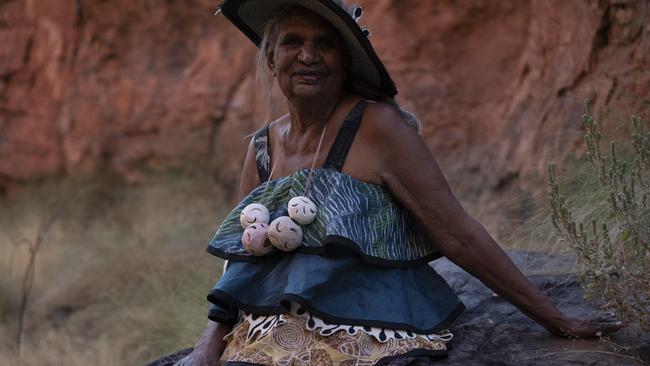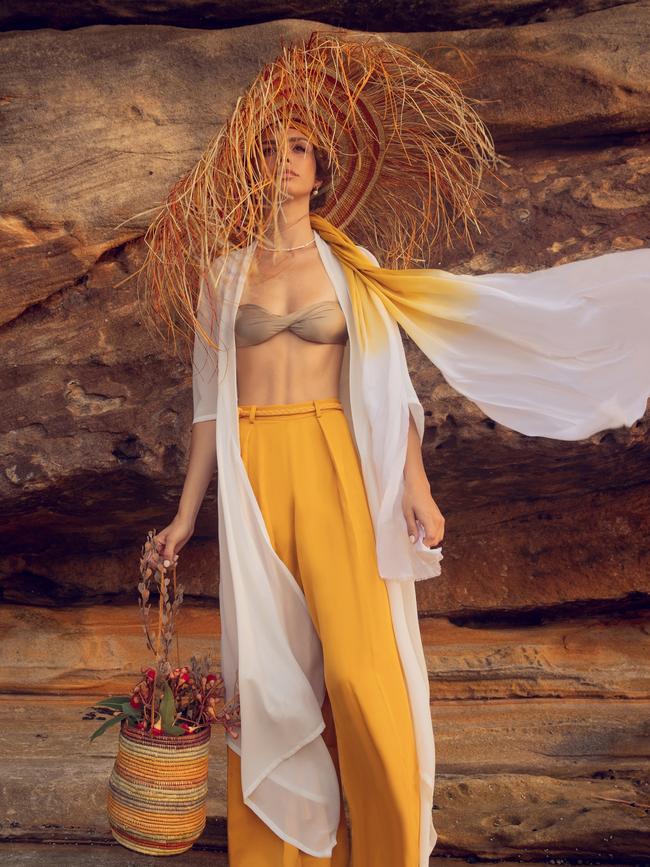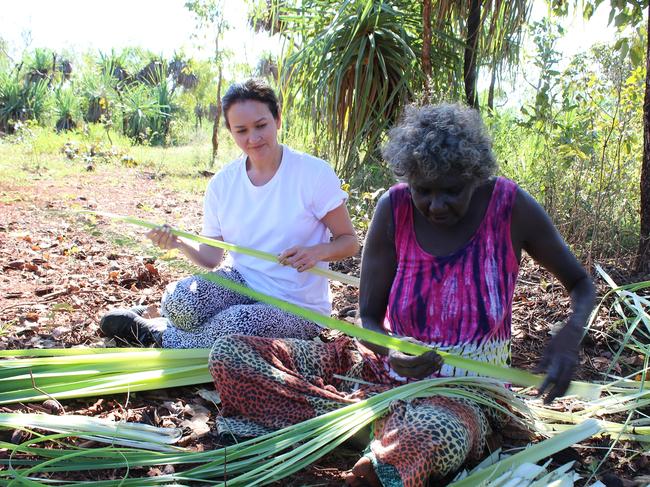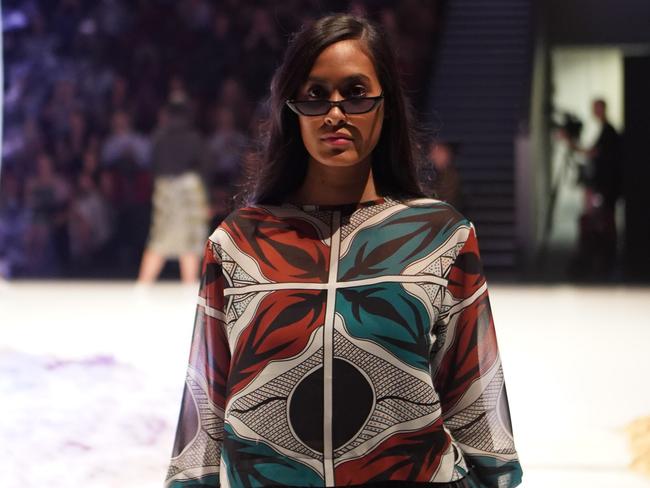Maara Collective, Peggy Griffiths and Bede Tungutalum win at National Indigenous Fashion Awards
The winners of the first National Indigenous Fashion Awards celebrate our cultural heritage in fashion form.

Fashion Design Award: Julie Shaw, Maara Collective
Australian design is known globally for its sophisticated approach to resort wear. With her label, Maara Collective, Yuwaalaraay designer Julie Shaw is hoping to tap into this market with her elegant pieces focusing on luxurious natural fibres, beautiful colours and handcrafted detailing.
After completing a bachelor of design at the University of Technology, Sydney and working for a number of labels including KCX International in Melbourne, Seduce in Sydney and a design studio in London, Shaw launched Maara Collective at the Darwin Aboriginal Art Fair’s Country to Couture catwalk show last year. Shaw says that this win will be invaluable for her fledgling label, through which she aims to highlight the work of Indigenous artists and designers through a range of collaborations.

“Being part of the awards brings recognition and visibility to our work and our brands and businesses, and (shows us) to the broader Australian fashion industry,” Shaw tells The Australian. “It’s exciting for an audience to discover talent with First Nations designers.
“I just hope that I can develop the business into something that could be seen as an Indigenous Australian brand that does continue to showcase talents of our artists with the cultural inspiration running through it.”
Community Collaboration Award: Julie Shaw X Bula’bula Arts
Collaboration is a pillar of Julie Shaw’s Maara Collective label: the word maara translates as hands in both Yuwaalaraay and Gamilaraay language groups. “It’s the essence of the brand,” says Shaw.
For this collection, Shaw collaborated with three Yolngu master weavers from the Bula’bula Art Centre in Northeast Arnhem Land; Mary Dhapalany, Evonne Munuyngu and Margaret Malibirr.
The women were happy with the win, saying, “Manymak (it’s good)”.
Shaw wanted to include woven accessories in her collection, and worked with the weavers to develop wide-brimmed hats, bags and belts.
After many conversations with the art centre, Shaw flew to Arnhem Land to spend time with the women, who invited the designer to go on country to take part in the sourcing and harvesting of pandanus leaves for weaving and roots and bulbs for dying the leaves vibrant yellow and red.
The process was fascinating for Shaw, who based the colours of her collection on the results.
“They set up an open fire and have big pots of boiling water, and put the pandanus in pots. They grind up the roots and bulbs by hand with grinding stones to make the dye paste. Once the leaves are all dyed different colours, they’re laid out to dry in the sun.

“Everything is completely natural, completely sustainable. We only took what we needed for the project at that time. The next day the leaves are all sorted into colour bundles and the ladies started weaving with them.”
“To be invited out on to country and to also be invited into the community to spend time, the whole thing was like a creative dream,” said Shaw.
Cultural Adornment & Wearable Art Award: Peggy Griffiths
Peggy Griffiths’s Legacy Dress is as layered with culture as it is with fabric.
The winning design from the senior Miriwoong artist is also a story of collaboration.
Designer Grace Lillian Lee, who has Chinese and Torres Strait Islander heritage on her father’s side, worked on the design with Griffiths, which incorporated the work of textile artists at Waringarri Arts in Kununurra, in Western Australia’s Kimberley Region. These artists include her daughter, Jan, and granddaughters Delany and Cathy.
Griffiths has been integral in passing down creative skills to young artists at Waringarri, where she introduced and developed the textiles program from 2016, both as a way of sharing cultural knowledge, but also creating livelihoods for women and young mothers in the local community.
The Legacy Dress is made up of 10 tiers of fabric, some hand-block-printed by the textile artists, handpainted by herself, or left plain. Designs include the jilinybeng, or bush cucumber, and boab nuts.
In a video for the awards, Griffiths’s daughter, Jan, said: “The Legacy Dress is made from bits of material from each of the textile girls, and me as well. It’s stories from my own people, so each of the layers represents each artist’s story.
“It’s another way of showing our art.”
Added Peggy: “(We) make sure we keep our culture strong as well. I am so proud of all the young artists. This is my country and my Dreaming here, that’s why I stayed.”
Bendigo Art Gallery has acquired the Legacy Dress, and it will appear in the upcoming exhibition, Piinpi: Contemporary Indigenous Fashion.
Social & Environmental Contribution Award: Ninti One
For decades there have been issues around intellectual property of Indigenous art and craft, with reproductions being mass-produced in other countries, then shipped in and sold as souvenirs, undercutting and disempowering local communities and artists.
Australian Indigenous development corporation Ninti One – which works with local communities to solve issues from health to education and more – has taken its previous research into the Aboriginal art industry to help neighbouring communities in Papua New Guinea.
Its winning project, Intellectual Property in PNG’s Creative and Cultural Industries, has developed a five-year road map for local communities, which includes educating consumers on authenticity, and advocating for government legislation against the importation of fake crafts, specifically bilum, traditional woven bags.
Ninti One’s cultural adviser, Leitha Assan, a Badhu woman from the Torres Strait, was able to create a cultural exchange with the PNG communities, sharing the work of Australian and Torres Strait Islanders in the same area.
Alison Page, chair of Ninti One, and a descendant of the Wadi Wadi and Walbanga people of the Yuin nation, told The Australian: “In the PNG case, you can tell where someone’s from by the colours and patterns and shapes in the bilums. Their identity is literally woven into these things.
“So when someone comes along and makes fake ones, it undermines not only their livelihoods, but the culture itself and the sustainability of their identities.
“The bigger piece in terms of the ongoing viability of communities and their cultures is helping them develop an industry which offers meaningful employment.
“Every day when a young person goes to work they’re engaging in this practice of weaving, which is a multi-generational practice that women do in Papua New Guinea.
“So every day you go to work you strengthen your identity. That’s the ultimate goal for everyone, isn’t it?”

Textile Design Award: Kieren Karritpul
Art runs in Kieren Karritpul’s blood, and his young age belies the success he has already achieved.
The 26-year-old Ngengi’Wurmurri man from the rak-Malfiyin estate of Daly River, Northern Territory, is following in the footsteps of his artist grandmother and great-grandmother.
The senior arts worker at Merrepen Arts has been creating art since the age of five, when he would paint and draw local flora and fauna, including “turtle, crocodile, bush tucker and berries”, he told The Australian.
Some of those early images are included in the exhibition of Karritpul’s work, Painting My Country Painting My Culture, which recently opened at Godinymayin Yijard Rivers Arts and Culture Centre in Katherine.
Karritpul’s signature style is a layered, kinetic approach to textile design. Starting with screenprinting his intricate patterns — which still draw on his local environment and implements — he then overlays additional lino prints or freehand designs over the top, bringing depth and movement. His work has been used in a number of contexts, and he loves to see it come to life “when people are wearing it, on furniture or on the wall”.
Karritpul’s Fishnets textile is featured at Darwin Airport, while a major coup later this year will come when his Baskets textile covers the publication Fabrics from the Top End, from the Fowler Museum in Los Angeles.
In 2015, one of his designs won the Telstra Art Award for young artists. Senior Indigenous art figures are expecting great things of Karritpul. “Djambawa Marawili won Telstra last year and said, ‘You are the next one’,” says Karritpul with a laugh.
Special Recognition Award: Bede Tungutalum
This year, textiles company Tiwi Design celebrates its 50th anniversary. It is only appropriate then that its co-founder, Bede Tungutalum, is acknowledged with this award for his pioneering work in Indigenous textiles, where he remains at the forefront of printmaking in the Tiwi Islands.
Having learnt woodblock printing as a boy through the local catholic mission at Nguiu, Bathurst Island, he and fellow student Giovanni Tipungwuti began creating commercial pieces; first a set of linen placemats that won the Good Design Award in 1970 from the Industrial Design Council of Australia.
Sensing an opportunity for their community, Tiwi Design was born.
“It all started with woodblock printing,” Tungutalum tells The Australian of the business. “Two years later we started on screenprinting, mostly placement prints. Back then we had about 10 girls doing our sewing, we used to make place mats, table cloths, wall hangings.”

Today, Tiwi Design works with around 100 artists on a number of artforms and media, including pandanus weaving, wood sculptures and screenprinting, mixing both traditional and contemporary styles.
Tungutalum’s personal work, which also includes painted wooden sculptures and carvings, quickly started to gain recognition around Australia and then the world. His first exhibition, with Tipungwuti, was in the Sebert Galleries in Sydney in 1971. In the decades since, his work has appeared in, and been collected by, galleries including the National Gallery of Australia, the Art Gallery of South Australia, Queensland Art Gallery, and the Art Gallery of Western Australia.
His 1988 Sandpiper design for Tiwi Design was prominently featured in the 2019 film Top End Wedding, worn by its star, Miranda Tapsell.
He has done cultural exchange programs in the UK and Canada, and around Australia, New Zealand and Papua New Guinea.
Of his practice, Tungutalum says: “Everything is in my head. It comes out when I sit down and relax and think about it. And bang – I go for it. I can still do the traditional and mix it with the new way. That’s what I live by – mix it up. It’s a gift from somewhere. We’ve all got gifts.”

To join the conversation, please log in. Don't have an account? Register
Join the conversation, you are commenting as Logout